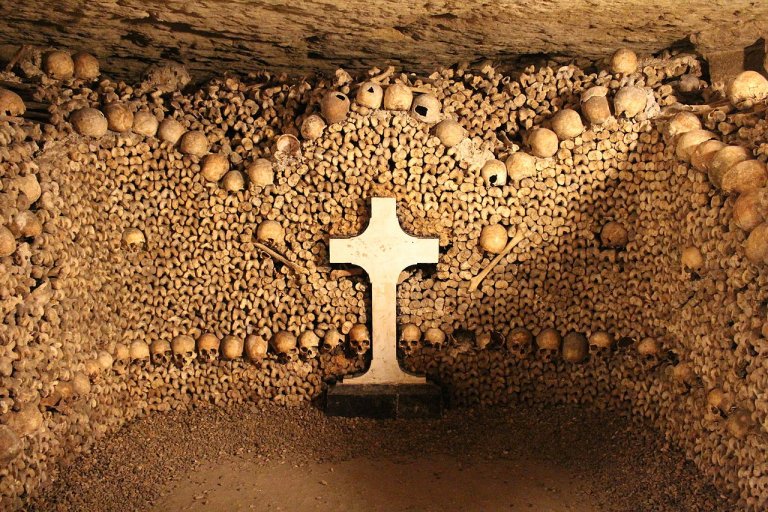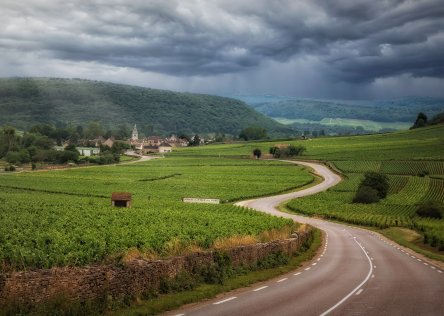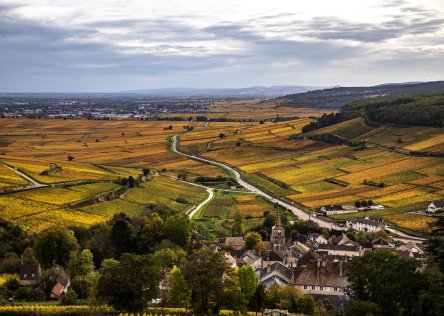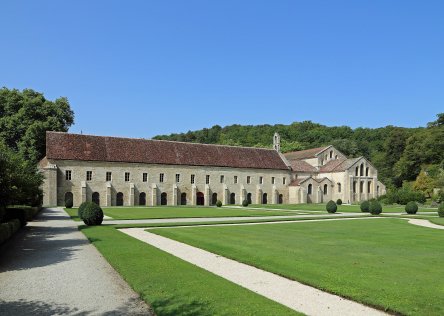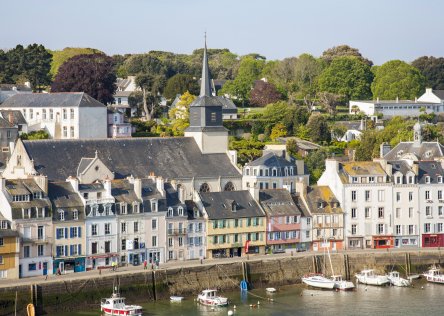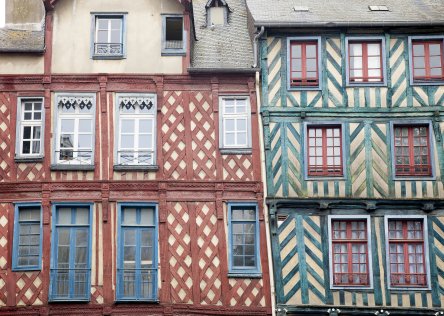What are the Paris Catacombs?
The underground catacombs in Paris are ossuaries that form a minor part of an ancient underground limestone and gypsum mining network. An ossuary is a container or space in which the bones of the dead are kept. The history of the catacombs in Paris dates back to the late 18th century, a time when the city’s cemeteries had become overcrowded, and in some cases, were overflowing. The conditions at Les Innocents cemetery were so bad that the ground level had risen by more than six feet, as bodies were buried on top of one another.
This presented a practical, logistical and ethical problem – they could not just keep on piling bodies on top of each other – as well as a public health concern. Les Innocents, which no longer exists today, had been used as a burial ground since the Middle Ages and in 1780 it was finally closed. In 1786, the remains were exhumed and transferred in covered wagons to a section of the old underground mining tunnels, which eventually became known as the Catacombs.
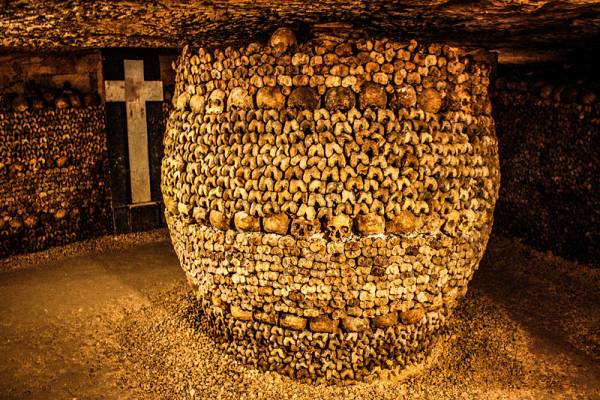
Catacombs of Paris - ©Wikimedia
Where are the Catacombs in Paris?
Access to the Paris Catacombs is in the district of Montparnasse. The nearest station is Denfert-Rochereau, which is on the RER B train line and on lines 4 and 6 of the Metro subway. It is not far from the Montparnasse cemetery, the final resting place of writers and artists including Jean-Paul Sartre, Simone de Beauvoir and Samuel Beckett.
The extensive mining tunnels in fact stretch over 180 miles across three main networks under the city of Paris. People tend to refer to the whole network as ‘the catacombs’. However, the catacombs are, in fact, only the small part containing the bones of more than six million people, covering just over one mile.
Why are the Catacombs so popular?
There seems to be a natural curiosity about the dead, including myths and legends about ghosts and the afterlife. The public has been able to visit the Paris Catacombs since the mid 19th century. However, interest from tourists has increased dramatically in the last few years.
In 2015, Airbnb launched a publicity stunt paying €350,000 to rent the tunnels for the night. The company offered the winner of an essay competition the chance to spend Halloween 2015 in the Catacombs. Since then, these underground tunnels lined with human skulls and bones have become one of the most popular places to visit in Paris.
Tips for visiting the Paris Catacombs
-
Catacombs tickets
Buy your Catacombs tickets for a set day and time online from the Paris museums’ website. The ‘skip-the-line’ catacombs ticket price is €29 euros and includes an audio guide. In reality, you will still need to line up to go down into the catacombs, as only 200 people are allowed down at a time. However, you won’t need to join the long queue to buy tickets, which can be hours long at peak times.
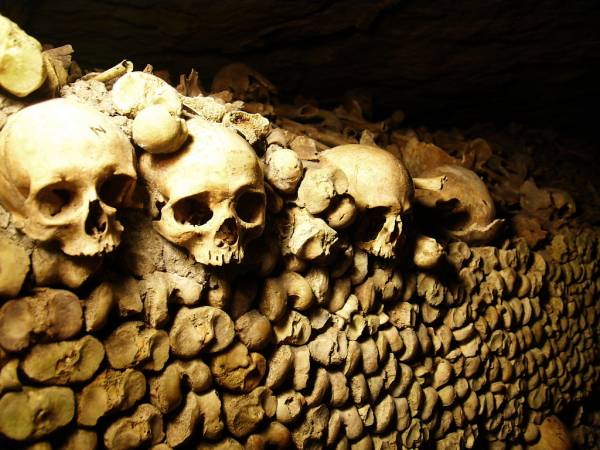
©Wikimedia
-
The best time to go to the Catacombs
In terms of the time of year, it is best to visit in the winter months when there are fewer tourists in Paris. However, if possible, try to avoid the Paris school holidays. These are usually around the last 10 days of December and the first week of January, and around the last week of February and the first week of March (check on Google to find the exact dates).
In terms of the best time of day to visit the Catacombs, try to go first thing in the morning (around 10 a.m.) or after 5 p.m. These are the least busy times in terms of visitor numbers. Keep in mind that in the winter, it will be dark after 5 p.m. in Paris. Therefore, unless you particularly want to visit the Catacombs at night, you may prefer to visit in the morning. The opening hours are Monday to Sunday from 10 a.m. to 8:30 p.m. No more tickets are sold after 7.30 p.m.
-
What to wear
It is chilly underground, so even if you visit in summer, be sure to bring a jacket with you. Parts of the ground in the underground tunnels are uneven, so wear some good walking shoes. Don't carry big bags as you can't take them with you and there aren't any lockers to leave them while you visit the site.
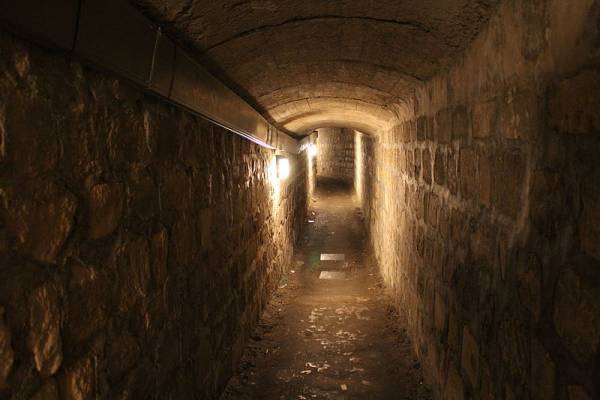
The access to the Catacombs can be scarry - not for claustrophobic travelers - ©Wikimedia
-
Accessibility and suitability
The underground tunnels accessible to visitors are a one-way, one-mile circuit. The estimated visit time is about 45 minutes. There are spiral staircases to enter and exit the catacombs - 131 steps on the way down and 112 steps on the way up. For this reason, they are not wheelchair accessible and are not recommended for people with physical disabilities or mobility difficulties. They are also not recommended for people who suffer from claustrophobia, anxiety or cardiac and respiratory conditions.
Please bear in mind that there are human bones and skulls lining the underground tunnels, and that this may be distressing for sensitive individuals and children.
Things to do near the Paris Catacombs
-
Visit the Montparnasse cemetery
See the final resting places of some famous French historical figures. These include:
Jean-Paul Sartre – a philosopher and writer
Simone de Beauvoir – a writer, feminist and philosopher married to Jean-Paul Sartre
Charles Baudelaire – a poet
Serge Gainsbourg – a singer-songwriter
André Citroën – an industrialist who created the Citroën car make
Susan Sontag - an American writer and filmmaker
Alfred Dreyfus - a French artillery officer of Jewish background whose trial and conviction in 1894 on charges of treason became one of the most tense political dramas in modern French history.
-
Visit the Fondation Cartier Contemporary Art Museum
If you enjoy contemporary art, see the latest exhibitions in this airy building designed by famous French architect Jean Nouvel.
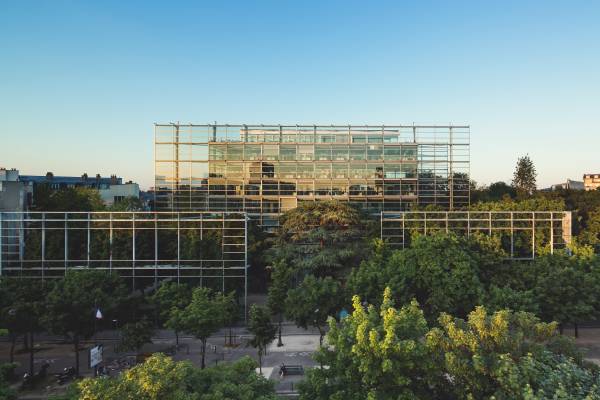
Cartier Fondation for Contemporary Art located on Boulevard Raspail - ©FJFY
-
Ascend the Montparnasse Tower
The observation deck at the top of the Montparnasse tower offers stunning 360-degree views of Paris, which include the Iron Lady, the Eiffel Tower herself. The lines are much shorter than at the Eiffel Tower and there is a café at the top in case you want to stop for a snack.
-
Stroll around the Luxembourg Gardens
The Jardin du Luxembourg was a favorite of American writer Ernest Hemingway when he was living in Paris in the 1920s. The gardens include a pretty pond and plenty of benches to relax on as you enjoy the French air and a picnic and do some people-watching. The Palais du Luxembourg, a former royal residence, is at the north of the gardens and is where the French senate now meets. Near the palace is the Musée du Luxembourg, which opened in 1750 and was the first public museum in Paris. There are some interesting art exhibitions in the museum.
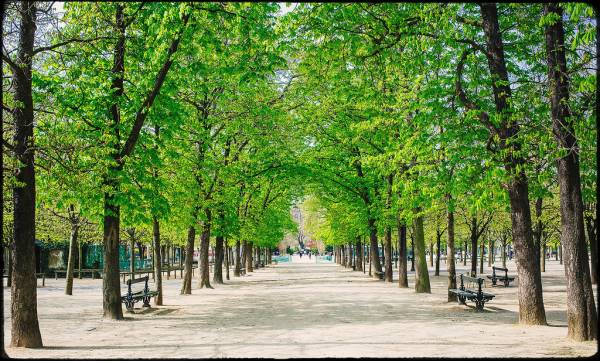
Stroll the Luxembourg Gardens - ©FJFY
-
See the Panthéon
Another famous resting place of notable French citizens, the Panthéon is an 18th-century mausoleum with a colonnaded facade. It is in Paris’s Latin Quarter, just to the east of the Luxembourg gardens and about a half-hour walk north of the Catacombs. Famous people interred at the Pantheon include:
Voltaire – a writer during the French Enlightenment
Jean-Jacques Rousseau – a French philosopher
Victor Hugo – French author best known outside of France for his novels Les Misérables and The Hunchback of Notre-Dame
Emile Zola – French writer and journalist
Alexandre Dumas – author of The Three Musketeers
Antoine de Saint-Exupéry – author of The Little Prince
Pierre and Marie Curie – Nobel Prize Winners
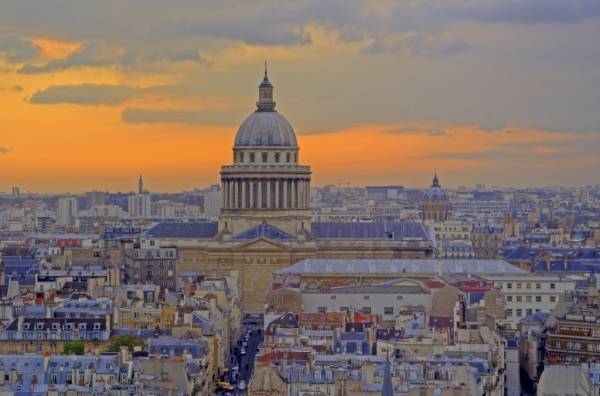
Panthéon Cupola in the Latin Quarter in Paris - ©Paris TO
Would you like to visit the Paris Catacombs?
If you would like to do a walking tour of the district of Montparnasse and/or visit the Paris Catacombs, let us know and we can include this in your Paris itinerary.
